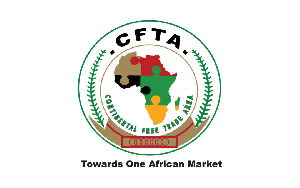President and Chairman of the Board of Directors of African Export-Import Bank, Prof. Benedict Oramah, has projected a rise in intra-African trade, stating that the current 15 to 17 per cent share is expected to double within the next decade, driven largely by the implementation of the African Continental Free Trade Area.
He made this known during the launch of the second volume of his book Foundations and Evolutions of Structured Trade Finance, held in Abuja on Wednesday.
The book launch was held on the sidelines of the 32nd Annual Meetings of the Afreximbank.
He said, “Another important aspect of these emerging dynamics is the increasing focus on intra-African trade. Currently averaging about 15–17 per cent, this share is expected to double within a decade as the Free Trade Agreement is fully implemented.”
Oramah explained that the dynamics of global trade have shifted significantly over the past decade, with South–South trade now dominating Africa’s external trade.
“Trade between Africa and other developing countries has risen significantly, growing from approximately 23 per cent of Africa’s total trade in 1995 to an estimated 68 per cent in 2024,” he continued.
In contrast, trade with advanced economies has declined to below 50 per cent.
He also noted that in the past, financing structures were built around North–South trade relationships, where trade with OECD countries dominated.
This shaped the earlier models of structured trade finance, which were necessary for managing country risk.
“Structured Trade Finance devised a way of transferring the unacceptable African country risks to the more acceptable country risk of OECD countries where the commodity buyer resides,” he said.
However, with the rise of intra-African trade and South–South linkages, the relevance of traditional structures is now under scrutiny.
Oramah added, “This shift raises important questions about the relevance of traditional Structured Trade Finance models in financing South-South trade. Specifically, how do lenders transfer payment risks associated with trade among developing countries?”
Beyond the changing trade directions, Oramah identified other emerging developments on the continent that are reshaping finance.
He pointed to the increasing discovery of oil, gas, and other natural resources across new African producers, saying this has “elevated the relevance of Reserve-Based lending.”
He also highlighted Africa’s ongoing reversal of the de-industrialisation trend, a development he described as significant for trade finance.
“Traditional trade finance structures, which are heavily focused on commodity finance, would require a rethink. With the rise of manufacturing giants in Africa, opportunities for the emergence of domestic and regional value chains, as well as the growth of small and medium-sized enterprises, are emerging,” he added.
The new volume of Oramah’s book, published by Globe Law and Business in London, addresses these developments and explores how innovative financing structures can help Africa maintain and expand its access to international trade finance.
The Afreximbank President described the new edition as a reflection of 33 years of experience in trade finance, stating, “The first and this new edition of the Book represent my effort to share the tremendous knowledge I have gained while practising trade finance over the past 33 years, primarily at Afreximbank.”
Business News of Thursday, 26 June 2025
Source: www.punchng.com













